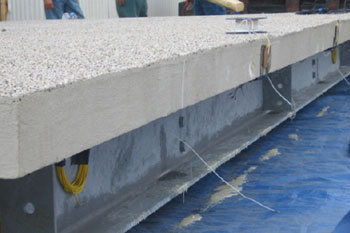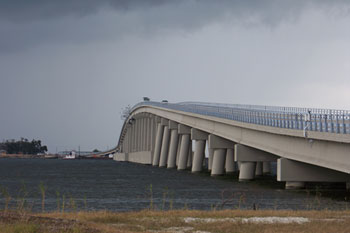A major LTRC thrust involves exploring the feasibility of using new resources to improve the long-term service of highways, bridges, and other transportation projects. Recent breakthroughs in materials constitute a key area where researchers are exploring the possibilities for use in the transportation industry.
The materials research group conducts in-house and contract research in the areas of asphalt technology, Portland cement concrete, and structural materials in a work program developed with the assistance of DOTD, university, and industry personnel. The Engineering Materials Characterization Research Facility (EMCRF) at LTRC conducts basic and applied research related to fundamental engineering characterization and performance of materials while providing technical support for both materials and geotechnical research. Learn more about each area below:
Asphalt |
Concrete |
Structures |
EMCRF
Asphalt
Bituminous materials have been a key component in highways since 1901 when Warren Paving Company began a then patented process which, coincidentally included a warranty. The study of asphalt materials, from the liquid asphalt or bitumen, to the mixture designs from Marshall to Superpave has been a very dynamic process. The challenge to build a structure to withstand the ever increasing truck loads with a flexible material has been met through sound construction practice, practical specifications, and plenty of asphalt materials research.
LTRC has been a leader in Asphalt Research since its inception and actually since the founding of the Louisiana Highway Research group in 1959. Over the years, Louisiana Asphalt Researchers have provided Louisiana DOTD with asphalt specifications based on knowledge and experience utilizing available materials.
The foundation for sound research is a well equipped and well staffed laboratory. Three certified technicians and two engineers manage the asphalt research within our 5,000 square feet of laboratory space and a mobile trailer that enables specimen to be made immediately during the construction process enabling expert field support for LTRC research projects.
Keeping up with the complex nature of asphalt research with the wide variety of testing required to quantify asphalt binders and mixtures requires University Support, and the LSU Chemistry Team along with our fully staffed Engineering Materials Characterization Laboratroy rounds out our very capable staff.
Concrete
Concrete Milestones
Concrete has been used for many centuries and continues to be one of the most commonly used materials to date. It dates back as early as 7,000 BC when lime-based, hydraulic cements were originally used for concretes. In 1756, John Smeaton presented the concept of "natural" hydraulic cements that was then used to construct the historic Erie Canal in 1818. In fact, natural hydraulic cements were used in US construction throughout most of the early 19th century. Years later, Joseph Aspdin invented the process of making Portland cement in 1824 in which he named the material after the Isle of Portland.
Solid Research
Today, Portland cement has become the most common type of cement used around the world, and the challenge to build pavements or structures with Portland cement concrete to withstand increasing truck loads is ongoing. LTRC has been conducting concrete materials research since its inception and has consistently met that challenge through
- a sound construction practice
- practical specifications
- a surplus of Portland cement concrete materials for research
Over the years, Louisiana Concrete Researchers have provided LADOTD with Portland cement concrete specifications based on knowledge and experience utilizing available materials.
Behind the Research
The foundation for reliable research is a well-equipped and well-staffed laboratory located in heart of LTRC. LTRC has Concrete Cement Reference Lab (CCRL) certification in concrete and aggregates. Three technicians as well as two engineers manage the concrete materials research within LTRC's 5,000 square foot laboratory.
Structures
With the nation's third highest total of bridge deck surface area and the largest inventory of movable bridges in the U.S., Louisiana depends on the variety of structures that bridge our many highways, railroads and waterways:
- Standard truss bridges with deepwater caisson foundations (including nine that span the Mississippi River alone)
- Cable-stayed bridges with deep water caisson or drilled shaft foundations (Luling and John James Audubon)
- Moveable bridges (vertical lift, swing span, bascule) spanning bayous
- Simple span bridges with precast girder with cast in place concrete deck
- Short span cast-in-place or precast
- Steel plate girder and splice bulb tee prestressed bridges for long navigation spans
All of these types of structures must perform in environments that are often exposed to salt water, hurricane force winds, navigational barge impact, soft compressible cohesive soils and storm surges along with ice and corrosion. Louisiana also has a heavy industrial climate that requires structural analysis and instrumentation of these bridge types to permit the one time passage of large overweight permit trucks through our highway system without causing damage. Research provides key support to answer the questions surrounding the design of new systems, the preservation or operation of our existing bridge systems.
LTRC's structures research group conducts in-house studies and coordinates contract research projects in areas such as high performance concrete (HPC) and fiber reinforced polymer (FRP), permit loads (sugar cane trucks), bridge pier fender protection systems, and prestressed girder continuity details.
This group with Bridge Design, manage Louisiana's participation in FHWA's Innovative Bridge Research and Deployment (IBRD) program. IBRD was established to promote, demonstrate, evaluate, and document the application of innovative designs, materials, and construction methods in the construction, repair, and rehabilitation of bridges and other highway structures.

FRP/Balsawood deck panel attached to a steel girder on LA 70 in Assumption Parish

Rigolets Pass Bridge with 78-in HPC Bulb-Tee Girders along route US 90 in Orleans Parish

Rigolets Pass Bridge with 78-in HPC Bulb-Tee Girders along route US 90 in Orleans Parish
EMCRF
The Engineering Materials Characterization and Research Facility (EMCRF) at LTRC conducts basic and applied research that is related to characterization and performance of transportation materials. In addition, EMCRF provides the necessary support for characterization of materials utilized in accelerated loading experiments.
EMCRF is equipped with state-of-the-art equipment to fundamentally characterize transportation materials. This includes two MTS materials test system and Superpave binder and mixture equipment.
Specialized Equipment
EMCRF is equipped to undertake a full range of standard and specialized tests used in fundamental characterization of transportation materials. This include a sophisticated materials research equipment such as two MTS Model 810 materials test systems that is fully automated to perform dynamic testing. The systems are rated for 22 Kip and 55 Kip, respectively. Both systems have digital controller operated under IBM OS/2 and MTS tester software for dat a acquisition and equipment control. Several user friendly menu driven software were developed to conduct test on asphaltic concrete samples such as indirect tensile strength and strain, indirect tensile and axial creep test, resilient modulus test, fati gue test, and other specified tests. In addition, software to conduct resilient modulus on subgrade soil is also available. Two environmental chambers are also available at the facility to provide testing capability at a range of temperature representi ng in-service pavement temperature. The temperature inside these chambers are controlled by microprocessor based controller for processing heating/cooling application. The operating range of the chamber is -100 F (-73 C) 600 F (356 C).
Louisiana Modified Indirect Tension Test Device
The EMCRF staff developed the Louisiana Modified Indirect Tension Test (LMITT) that is currently used to conduct fundamental testing on transportation materials in the indirect tension mode. Displacement measurement to dynamic loadin g is a critical factor in determining the fundamental properties of transportation materials. A typical range of the deformation along the horizontal diameter during the dynamic load application is 4-100 micro-inches. Thus, the measurement device must have the sensitivity in this range so that it can respond and capture the change in sample deformation resulting from the application of dynamic loads.
Superpave Performance Based Binder and Mixture Equipment
SHRP Testing Equipment
From October 1987, through March 1993, the Strategic Highway Research Program (SHRP) conducted a $50 million research effort to develop new ways to specify, test, and design asphalt materials. The final product of the SHRP asphalt re search program is a new system referred to as Superpave TM ,which stands for Superior Performing Asphalt Pavements. It represents an improved system for specifying the components of asphalt concrete, asphalt mixture design and analysis, and asphalt pavement performance prediction.
EMCRF and the asphalt Laboratory at LTRC is equipped with the new SHRP Superpave asphalt binder and mixture tests equipment. Superpave binder equipment include the dynamic shear rheometer, bending beam rheometer, the direct tension a pparatus, the presssure age vessel, and Brookfield rotational Viscometer. The mixture equipment at EMCRF include the Superpave Gyratory Compactor and the Simple Shear tester.
Resilient Modulus Testing of Subgrade Soil
The resilient modulus is very sensitive, among other things, to the testing equipment and the testing procedure. Misalignment, seating errors, bedding errors, and end friction can cause erroneous axial measurements and thereby affect the resilient modulus calculations. The end friction between the sample and platens induces stress/strain concentrations at the ends and this results in a non-uniform strain distribution down the axis of the specimen. Measurements inside the cell are found to reduce the bedding, seating and system compliance problems. It is also reported that the use of inside measurements has been found to be important for granular materials whose resilient modulus is greater than 105 MPa (15000 psi). EMCRF conducts resilient modulus testing using a MTS model 810 servo-hydraulic material testing system with a 100 kN (22 kip) axial load actuator capacity. The experimental setup consists of pressure panel, MTS 810 load system, analog controller, triaxial cell and accessories, signal conditioning module, high speed personal computer equipped with data acquisition hardware and software, and MTS micro-controller.
Deformations and load are measured inside the triaxial cell. The triaxial cell is custom made with connectors for two deformation measurement systems and an internal load cell with a capacity of 1.36 kN (300 lbs). The pressure trans ducer, used in measuring the confining stress, has a full scale of 700 kPa (100 psi) with a combined repeatability and non-linearity of ±2.31 kPa (0.33 psi). Two independent measurement systems can be used simultaneously to monitor the axial deformation. The first system is used to measure specimen deformation with LVDTs clamped at one-third points in from each end of the specimen. The clamps which are made of plexiglas material, do not provide any rigid confinement to the sample since they are in cont act with sample at four point-locations. This system measures displacements between two points on each side of the sample. The second system is used to monitor the deformation with LVDTs mounted at the end plates. The second system has external adjusta ble knobs in the triaxial cell allows to externally re-zero the LVDTs without opening the cell chamber. Both measurement systems have two diametrically placed internal LVDTs. The deformation in each system is measured with two LVDTs mounted 180 degrees a part from each other. The output from each LVDT is monitored independently and compared with the output of the other LVDT of the same system. If the difference between the axial deformations was not within the assigned tolerance, then the tests will be discarded. This ensures good seating and uniform loading on the specimen.
In order to minimize errors in data collection, all outputs from the instrumentation devices, described in previous sections, were conditioned prior to digitizing by the analog/digital (A/D) board and stored in the high speed personal computer. A 16-bit data acquisition board, along with a signal conditioning unit capable of providing 8 active channels was used for data collection. The minimum values that could be read for end system LVDTs, middle system LVDTs, load cell and cell pr essure transducers were 0.00309 mm, 0.0014 mm, 3.3 N and 0.35 kPa, respectively. A fully automated test software for equipment control, data acquisition and data reduction was developed.